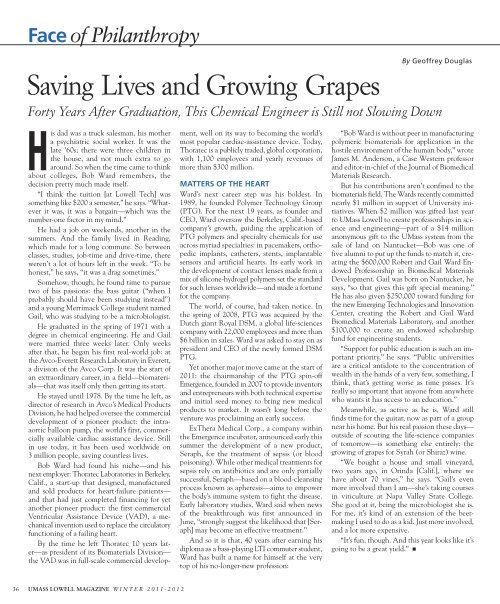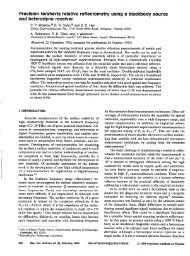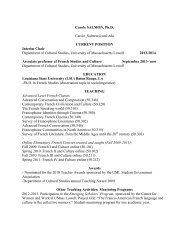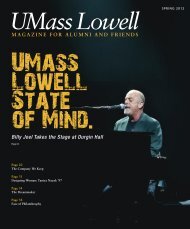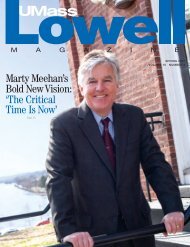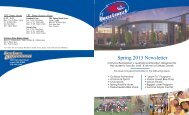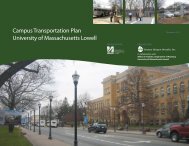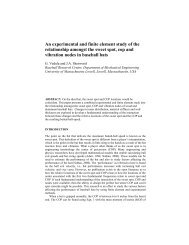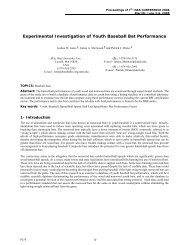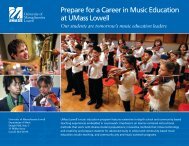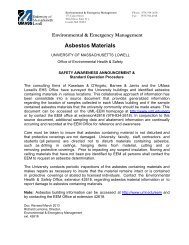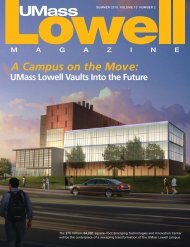Winter 2012 - University of Massachusetts Lowell
Winter 2012 - University of Massachusetts Lowell
Winter 2012 - University of Massachusetts Lowell
Create successful ePaper yourself
Turn your PDF publications into a flip-book with our unique Google optimized e-Paper software.
Face <strong>of</strong> Philanthropy<br />
By Ge<strong>of</strong>frey Douglas<br />
Saving Lives and Growing Grapes<br />
Forty Years After Graduation, This Chemical Engineer is Still not Slowing Down<br />
His dad was a truck salesman, his mother<br />
a psychiatric social worker. It was the<br />
late ’60s; there were three children in<br />
the house, and not much extra to go<br />
around. So when the time came to think<br />
about colleges, Bob Ward remembers, the<br />
decision pretty much made itself.<br />
“I think the tuition [at <strong>Lowell</strong> Tech] was<br />
something like $200 a semester,” he says. “Whatever<br />
it was, it was a bargain—which was the<br />
number-one factor in my mind.”<br />
He had a job on weekends, another in the<br />
summers. And the family lived in Reading,<br />
which made for a long commute. So between<br />
classes, studies, job-time and drive-time, there<br />
weren’t a lot <strong>of</strong> hours left in the week. “To be<br />
honest,” he says, “it was a drag sometimes.”<br />
Somehow, though, he found time to pursue<br />
two <strong>of</strong> his passions: the bass guitar (“when I<br />
probably should have been studying instead”)<br />
and a young Merrimack College student named<br />
Gail, who was studying to be a microbiologist.<br />
He graduated in the spring <strong>of</strong> 1971 with a<br />
degree in chemical engineering. He and Gail<br />
were married three weeks later. Only weeks<br />
after that, he began his first real-world job: at<br />
the Avco-Everett Research Laboratory in Everett,<br />
a division <strong>of</strong> the Avco Corp. It was the start <strong>of</strong><br />
an extraordinary career, in a field—biomaterials—that<br />
was itself only then getting its start.<br />
He stayed until 1978. By the time he left, as<br />
director <strong>of</strong> research in Avco’s Medical Products<br />
Division, he had helped oversee the commercial<br />
development <strong>of</strong> a pioneer product: the intraaortic<br />
balloon pump, the world’s first, commercially<br />
available cardiac assistance device. Still<br />
in use today, it has been used worldwide on<br />
3 million people, saving countless lives.<br />
Bob Ward had found his niche—and his<br />
next employer: Thoratec Laboratories in Berkeley,<br />
Calif., a start-up that designed, manufactured<br />
and sold products for heart-failure patients—<br />
and that had just completed financing for yet<br />
another pioneer product: the first commercial<br />
Ventricular Assistance Device (VAD), a mechanical<br />
invention used to replace the circulatory<br />
functioning <strong>of</strong> a failing heart.<br />
By the time he left Thoratec 10 years later—as<br />
president <strong>of</strong> its Biomaterials Division—<br />
the VAD was in full-scale commercial development,<br />
well on its way to becoming the world’s<br />
most popular cardiac-assistance device. Today,<br />
Thoratec is a publicly traded, global corporation,<br />
with 1,100 employees and yearly revenues <strong>of</strong><br />
more than $300 million.<br />
MATTERS OF THE HEART<br />
Ward’s next career step was his boldest. In<br />
1989, he founded Polymer Technology Group<br />
(PTG). For the next 19 years, as founder and<br />
CEO, Ward oversaw the Berkeley, Calif.-based<br />
company’s growth, guiding the application <strong>of</strong><br />
PTG polymers and specialty chemicals for use<br />
across myriad specialties: in pacemakers, orthopedic<br />
implants, catheters, stents, implantable<br />
sensors and artificial hearts. Its early work in<br />
the development <strong>of</strong> contact lenses made from a<br />
mix <strong>of</strong> silicone-hydrogel polymers set the standard<br />
for such lenses worldwide—and made a fortune<br />
for the company.<br />
The world, <strong>of</strong> course, had taken notice. In<br />
the spring <strong>of</strong> 2008, PTG was acquired by the<br />
Dutch giant Royal DSM, a global life-sciences<br />
company with 22,000 employees and more than<br />
$6 billion in sales. Ward was asked to stay on as<br />
president and CEO <strong>of</strong> the newly formed DSM<br />
PTG.<br />
Yet another major move came at the start <strong>of</strong><br />
2011: the chairmanship <strong>of</strong> the PTG spin-<strong>of</strong>f<br />
Emergence, founded in 2007 to provide inventors<br />
and entrepreneurs with both technical expertise<br />
and initial seed money to bring new medical<br />
products to market. It wasn’t long before the<br />
venture was proclaiming an early success.<br />
ExThera Medical Corp., a company within<br />
the Emergence incubator, announced early this<br />
summer the development <strong>of</strong> a new product,<br />
Seraph, for the treatment <strong>of</strong> sepsis (or blood<br />
poisoning). While other medical treatments for<br />
sepsis rely on antibiotics and are only partially<br />
successful, Seraph—based on a blood-cleansing<br />
process known as apheresis—aims to empower<br />
the body’s immune system to fight the disease.<br />
Early laboratory studies, Ward said when news<br />
<strong>of</strong> the breakthrough was first announced in<br />
June, “strongly suggest the likelihood that [Seraph]<br />
may become an effective treatment.”<br />
And so it is that, 40 years after earning his<br />
diploma as a bass-playing LTI commuter student,<br />
Ward has built a name for himself at the very<br />
top <strong>of</strong> his no-longer-new pr<strong>of</strong>ession:<br />
“Bob Ward is without peer in manufacturing<br />
polymeric biomaterials for application in the<br />
hostile environment <strong>of</strong> the human body,” wrote<br />
James M. Anderson, a Case Western pr<strong>of</strong>essor<br />
and editor-in-chief <strong>of</strong> the Journal <strong>of</strong> Biomedical<br />
Materials Research.<br />
But his contributions aren’t confined to the<br />
biomaterials field. The Wards recently committed<br />
nearly $1 million in support <strong>of</strong> <strong>University</strong> initiatives.<br />
When $2 million was gifted last year<br />
to UMass <strong>Lowell</strong> to create pr<strong>of</strong>essorships in science<br />
and engineering—part <strong>of</strong> a $14 million<br />
anonymous gift to the UMass system from the<br />
sale <strong>of</strong> land on Nantucket—Bob was one <strong>of</strong><br />
five alumni to put up the funds to match it, creating<br />
the $600,000 Robert and Gail Ward Endowed<br />
Pr<strong>of</strong>essorship in Biomedical Materials<br />
Development. Gail was born on Nantucket, he<br />
says, “so that gives this gift special meaning.”<br />
He has also given $250,000 toward funding for<br />
the new Emerging Technologies and Innovation<br />
Center, creating the Robert and Gail Ward<br />
Biomedical Materials Laboratory, and another<br />
$100,000 to create an endowed scholarship<br />
fund for engineering students.<br />
“Support for public education is such an important<br />
priority,” he says. “Public universities<br />
are a critical antidote to the concentration <strong>of</strong><br />
wealth in the hands <strong>of</strong> a very few, something, I<br />
think, that’s getting worse as time passes. It’s<br />
really so important that anyone from anywhere<br />
who wants it has access to an education.”<br />
Meanwhile, as active as he is, Ward still<br />
finds time for the guitar, now as part <strong>of</strong> a group<br />
near his home. But his real passion these days—<br />
outside <strong>of</strong> scouting the life-science companies<br />
<strong>of</strong> tomorrow—is something else entirely: the<br />
growing <strong>of</strong> grapes for Syrah (or Shiraz) wine.<br />
“We bought a house and small vineyard,<br />
two years ago, in Orinda [Calif.], where we<br />
have about 70 vines,” he says. “Gail’s even<br />
more involved than I am—she’s taking courses<br />
in viticulture at Napa Valley State College.<br />
She good at it, being the microbiologist she is.<br />
For me, it’s kind <strong>of</strong> an extension <strong>of</strong> the beermaking<br />
I used to do as a kid. Just more involved,<br />
and a lot more expensive.<br />
“It’s fun, though. And this year looks like it’s<br />
going to be a great yield.” <br />
36 UMASS LOWELL MAGAZINE W I N T E R 2 0 1 1 - 2 0 1 2


